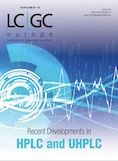Looking To The Future
Special Issues
An introduction from the guest editor of this special supplement from LCGC Europe revealing recent developments in high performance liquid chromatography (HPLC) and ultrahigh-pressure liquid chromatography (UHPLC).

An introduction from the guest editor of this special supplement from LCGC Europe revealing recent developments in high performance liquid chromatography (HPLC) and ultrahigh-pressure liquid chromatography (UHPLC).
I am delighted to present to you key developments in the field of ultrahighâpressure liquid chromatography (UHPLC) and high performance liquid chromatography (HPLC) by four leading researchers. With their contributions, they give an overview of the concepts and visions that will, at least in my opinion, dominate the future research in column technology in HPLC and UHPLC.
One vision that gets progressively more and more supported by the literature is the fact that the current column hardware is no longer adequate to maintain the very high efficiencies and small peak volumes produced by the high-quality particles (ever smaller, with an ever narrower particle size distribution) and highâquality packings (obtained by ever more optimized packing procedures) that have now become state-of-the-art. The inadequacy of the current column hardware is the main theme in the contribution by Fabrice Gritti, revealing how the current bulky column design and the way our columns are installed in our instruments are unsuited to remove the viscous friction heat one can expect when using state-of-the-art columns at their top speed. Having removed a major fraction of the excess thermal mass plaguing the current column format, and having developed an ingenious permanent vacuum enclosure solution to let the column operate in a nearâperfect adiabatic mode, 95% of the maximum expected efficiency could be achieved.
Nobuo Tanaka, still pushing to break chromatographic records and achieve record efficiencies, shows in his contribution that column technology should not be restricted to the conventional single-column paradigm, but that multicolumn systems (one of my favourite topics) can be conceived to increase the versatility, speed, and efficiency of the analysis. More specifically, Tanaka et al. used recycled chromatography to produce ultrahighâefficiencies, capable of separating aromatic hydrocarbons based on the difference of one H/D substitution down to a relative retention ratio of α = 1.008.
Next to hardware-another of my pet topics to emphasize how our instruments (and columns) could be empowered by adding much more intelligence than is the case today. While software and artificial intelligence are literally revolutionizing our world as we speak, little or no effort is being made to incorporate these concepts in the area of chromatography. However,
as advocated by Dan Armstrong and his team, chromatography is an area that can highly benefit from a variety of digital signal processing techniques. Signal processing is fully accepted in other areas, such as spectroscopy, but has barely been explored to its full potential in chromatography, certainly not at a commercial level. The authors illustrate this by providing a comprehensive overview of recent data analysis algorithms that can be used to enhance the signal-toânoise ratio (S/N) and even separation resolution. The techniques they describe are easy to program and the authors see no reason why they would not be incorporated in future instrument software versions.
It is also written in the stars that more and more attention will be paid to tighter connection between LC and mass spectrometry (MS) instruments, both in terms of an advanced hardware integration as well as a better chemical integration. While the former is one of the prominent aspects of the contribution of Gritti (see the part on the integrated column/electrospray ionization [ESI] probe), the contribution of Szabolcs Fekete, Davy Guillarme, and co-workers addresses the second issue. Considering the very timely application of the ion-exchange separation and MS detection of monoclonal antibodies (mAbs) and related products, they show how an in-depth and systematic study of recently proposed MS-friendly buffers, such as ammonium acetate and ammonium carbonate or bicarbonate, can be used to understand and optimize the impact of ionic strength, buffer capacity, and pH-response on the retention behaviour and peak shape of mAb species.
In conclusion, I am convincedthe high-level contributions in this LCGC supplement show column technology has not fully matured yet as some believe. On the contrary, there is still a large progression margin and many challenges ahead. For example, there is a growing field of (potential) applications in the life sciences where LC is still too slow and does not offer enough separation capacity. Improvements in column technology will be the key to overcome these limitations. Hopefully one day, these improvements will lead to an era where LC finally offers the same efficiency as gas chromatography (GC), a wish and a vision once formulated by Pat Sandra.

A Novel LC–QTOF-MS DIA Method for Pesticide Quantification and Screening in Agricultural Waters
May 8th 2025Scientists from the University of Santiago de Compostela developed a liquid chromatography quadrupole time-of-flight mass spectrometry (LC–QTOF-MS) operated in data-independent acquisition (DIA) mode for pesticide quantification in agriculturally impacted waters.
Investigating 3D-Printable Stationary Phases in Liquid Chromatography
May 7th 20253D printing technology has potential in chromatography, but a major challenge is developing materials with both high porosity and robust mechanical properties. Recently, scientists compared the separation performances of eight different 3D printable stationary phases.

.png&w=3840&q=75)

.png&w=3840&q=75)



.png&w=3840&q=75)



.png&w=3840&q=75)








